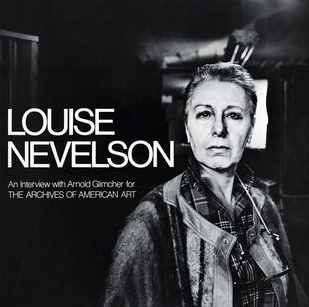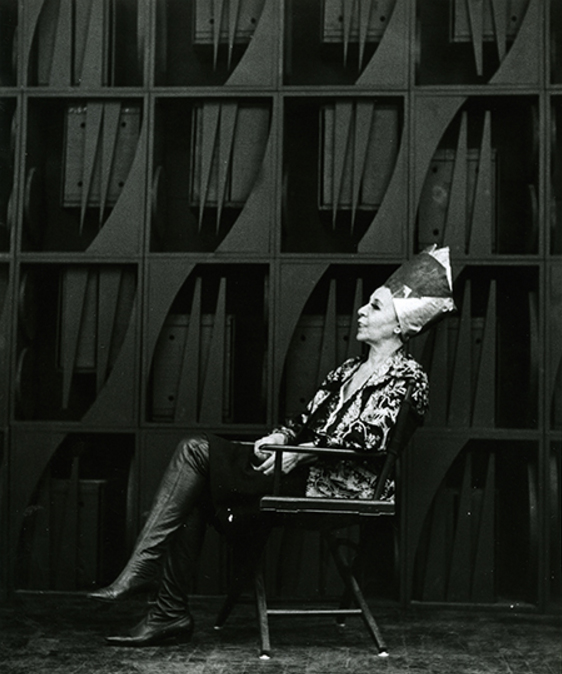
“I fell in love with black; it contained all color. It wasn’t a negation of color. It was an acceptance. Because black encompasses all colors. Black is the most aristocratic color of all… You can be quiet, and it contains the whole thing.” [Louise Nevelson] Image and quote courtesy of Alabama Chanin.
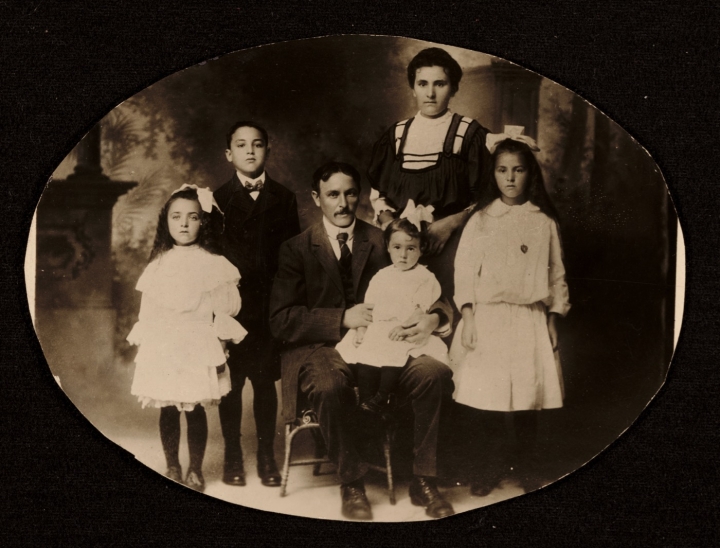
A Berliawsky family portrait, circa 1907. Image and details courtesy of Hyperallergic.
Louise Nevelson, née Berliawsky, was born in Kiev as the second of four children in September 1899. According to The New York Times, her father immigrated to Rockland, Maine, in 1902 and remained in the family tradition of working in the timber industry. Shortly thereafter Louise and her family joined her father in Maine.
“‘I’m going to be an artist…a sculptor. I don’t want color to help me.” A feeling for wood had been bred into her, and by the time she was 6 she was already working with small pieces of wood that she had scavenged from her father’s lumber yard. She told friends in later years that in school she was always cold and only found warmth when she was in art class.
While she had always been encouraged by her parents and family to pursue her artistic instincts, although not by Charles Nevelson during their brief marriage, it took Nevelson time to experiment, develop, and hone her signature monochromatic style.
She was a practicing and recognized artist who was active in many groups since the 1930s. However, it would not be until the mid-1950s that Nevelson became highly sought after. Two traits stayed with Louise from her refugee childhood to adulthood and helped construct her luminary persona to endure the test of time: resourcefulness and her eccentric way of dressing.
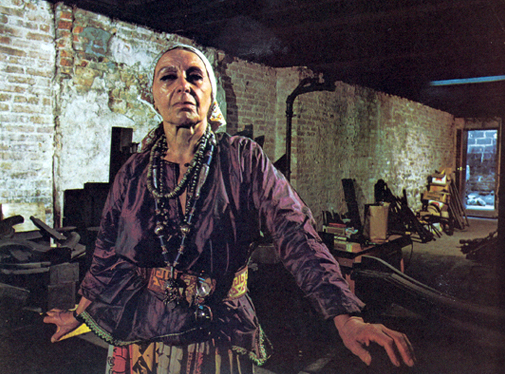
“Everytime I put on clothes, I’m creating a picture.” [Louise Nevelson]. Quote Courtesy of Dawns & Dusks: Taped Conversations with Diana MacKown and image courtesy of the Louise Nevelson Foundation.
Her artistic style evolved from tabletop objects to the wall-scaling grids, it fused the geometry of Cubism and the epic scale of Abstract Expressionism. Her most powerful pieces are painted a matte black, others in a lunar white.
In the spring 1936, Nevelson entered a competitive exhibition at the A. C. A. Gallery in New York City and was one of four artists invited to show at during the A. C. A. in September. Her work in September was caught the eye of The New York Times and her sculptures were described in detailed coverage as ”unlike anything we’ve ever seen before.”
She had her first solo exhibition at Nierendorf Gallery in New York in 1941, the first solo show of the gallery which featured an American. It was here “the original recycler” gave a second and artistic life to discarded wood, boxes, and other miscellaneous objects.
In the mid-1950s, after producing her first series of black wood landscape sculptures, three New York City museums acquired her work: The Whitney Museum of American Art purchased Black Majesty (1956), The Brooklyn Museum purchased First Personage (1957) and The Museum of Modern Art purchased Sky Cathedral (1958).
A 1958 exhibition of her all-black environments caused a sensation. Nevelson called her works “environments” because the work was so imposing in size that a critic said it “violates our received ideas on the limits of sculpture and on the confusion of genres, so large that the spectator is invited to feel ‘placed’ (or trapped?) within it.”
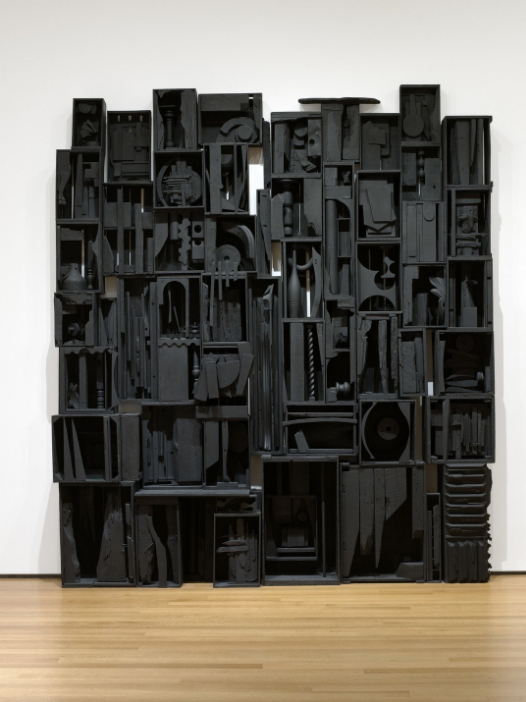
Louise Nevelson, Sky Cathedral, 1958. Painted wood. 11’ 3 1/2″ x 10’ 1/4″ x 18”. Image and details courtesy of MoMA.
During the 1960s and 1970s Nevelson experimented with industrial materials such as steel, plexiglass, and aluminum. These new materials allowed her to expand the scale and complexity of her works. Additionally it paved a path for her sculptures to be installed in public spaces and provided a direct interaction with all surroundings as stated by The Art Story.
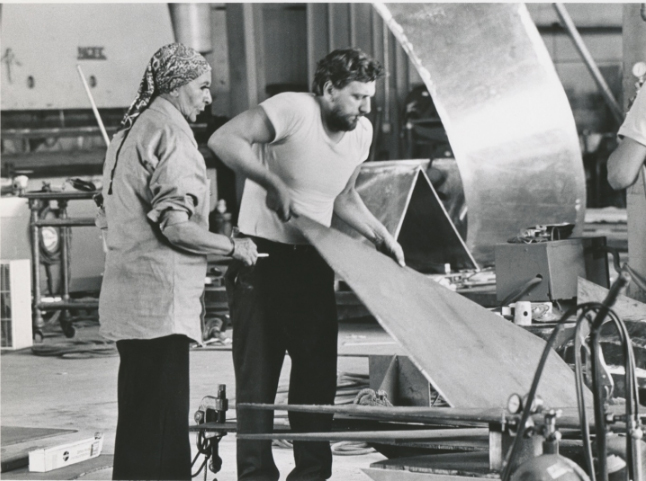
Louise Nevelson shown with Bobby Giza at Lippincott, Inc. 1975 (photograph by Roxanne Everett / Lippincott’s, LLC). Lippincott, Inc. was created as an artist-friendly environment where sculptors could have their large-scale works fabricated in a manner that was sensitive to their needs and methods. Lippincott would go on to produce work for many artists.

Louise Nevelson, Mrs. N’s Palace, 1964-77. Painted wood, mirror. 140″ x 239″ x 180″.
When originally installed at The Met in the 1980s, The New York Times noted visitors could walk on the mirror-like floor making Mrs. N’s Palace a preview of the installation art we have come to know today.
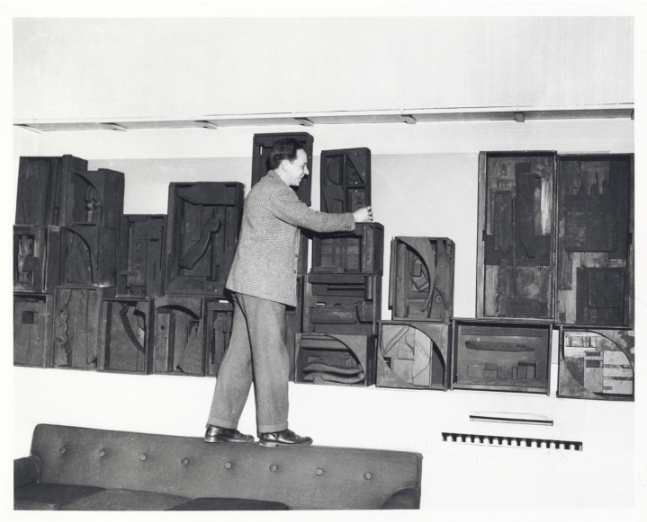
Mike Nevelson, son, shown installing Sky Cathedral #2 (1957) at the Thorndike Hotel, 1959. Image and caption details courtesy of Hyperallergic.
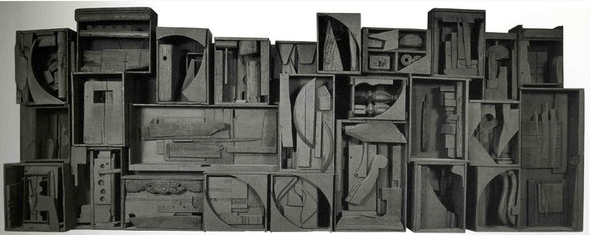
Louise Nevelson, Sky Cathedral #2 (1957), once at the Thorndike Hotel, now at San Jose Museum of Art, acquired in 2011.
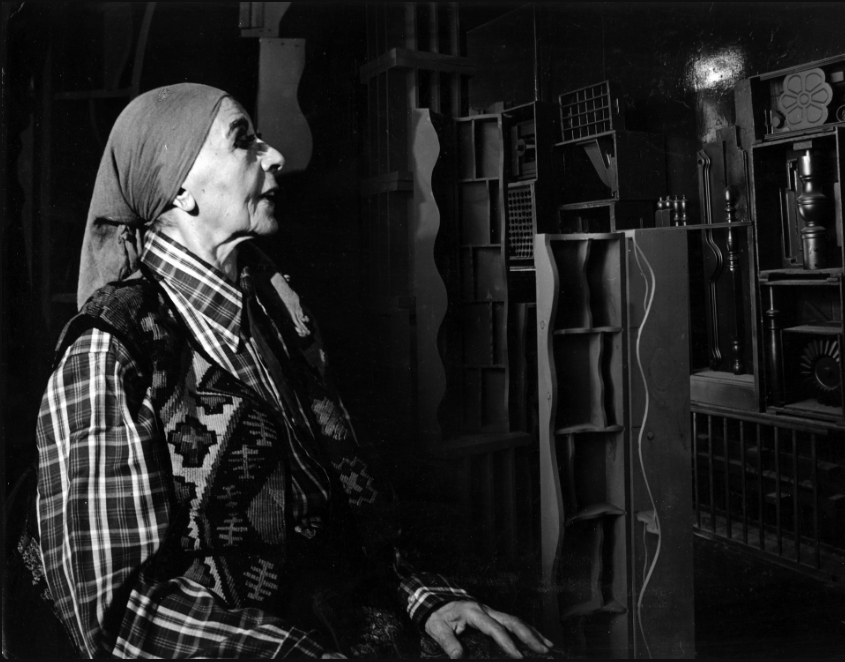
A photograph of Louise taken by Pedro E. Guerrero and discussed on PBS. Pedro had photographed Louise and her artwork in her home, studios, public installation sites, and museums. In his book Pedro describes working with the artist.
Nevelson’s work challenged Pedro’s photography skills, “Separating black from black, trying to show dimension and depth of color…I had to figure out how to make one black object stand out from the next, to show it had texture and depth.” [Pedro E. Guerrero]
Even after her death in 1988, Nevelson’s work continues to mesmerize art collectors and designers alike. She is featured in many solo and group exhibitions and is in many esteemed public and private art collections.
A full list of her extensive public collections is available at the Louise Nevelson Foundation.
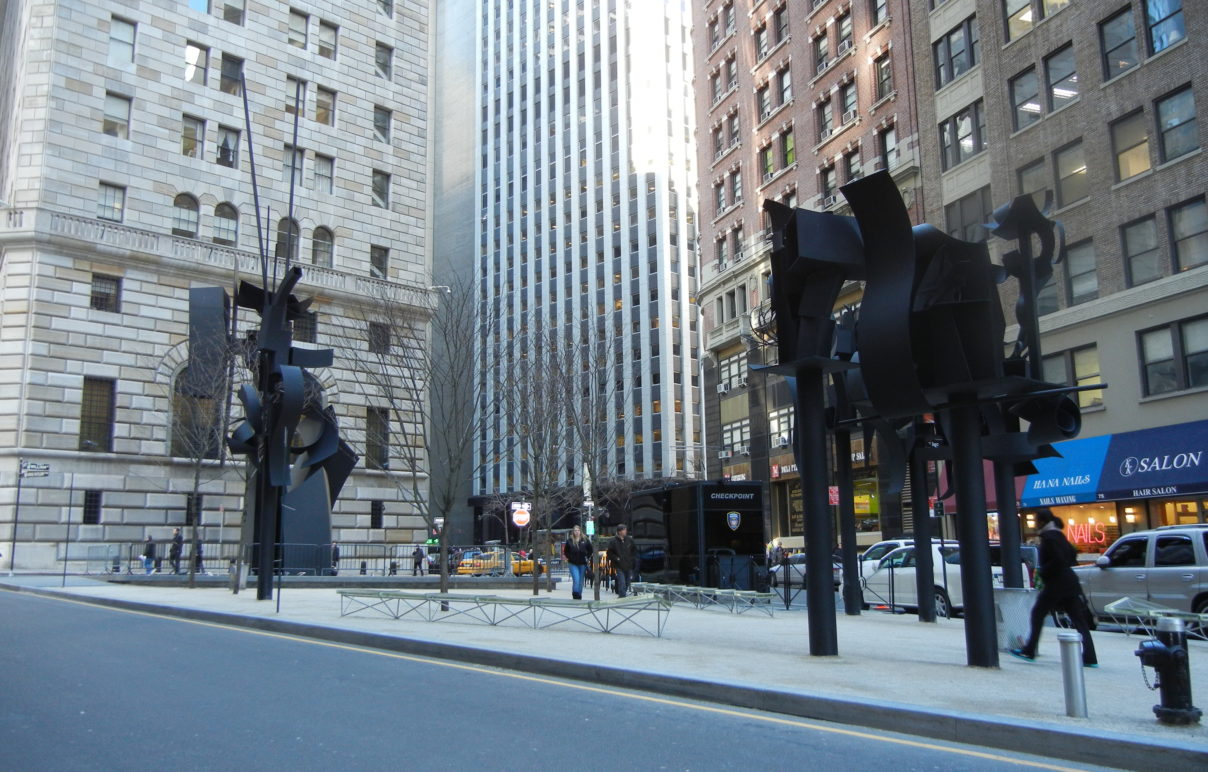
Louise Nevelson, Shadows and Flags, Louise Nevelson Plaza, 1977-78. Triangular intersection of Liberty Street, William Street, and Maiden Lane. Image courtesy of Pinterest and details courtesy of Lower Manhattan Cultural Council.
Louise Nevelson Plaza was the very first public plaza in New York City to be named after an artist. The plaza features seven sculptures that make up Shadows and Flags (1977-78). The sculptures are constructed from Cor-ten Steel and painted in Nevelson’s signature color black.
In her lifetime Nevelson would go on to create over twenty public commissions. These commissions made her one of the most prolific sculptors producing large-scale work during the public art resurgence.
Suzanne Lovell, Inc. is grateful to include artwork by Louise Nevelson in our portfolio. Nevelson remains an inspiration to our team and clients as well as other interior designers.
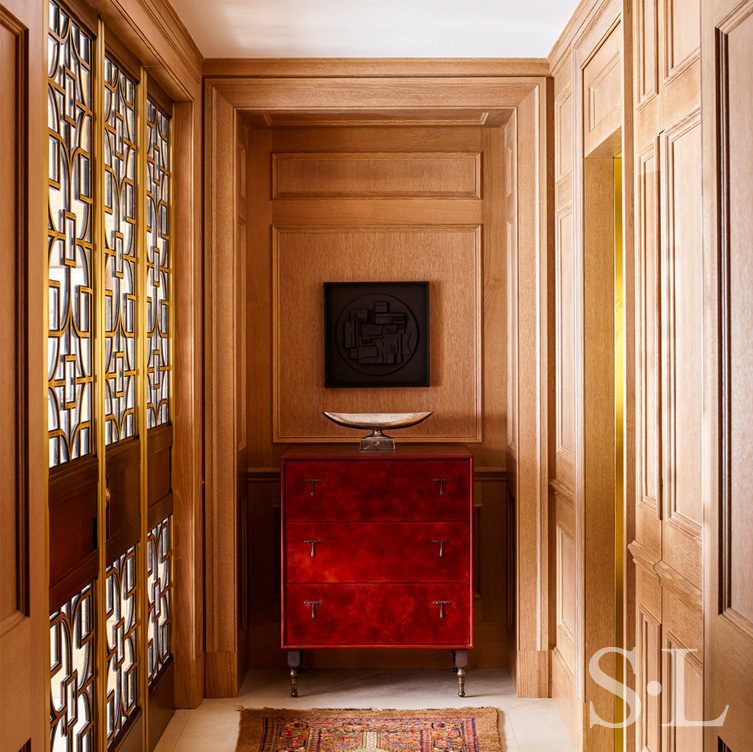
Louise Nevelson, Full Moon, 1980. 18 1/2″ x 18 1/2″ x 2 1/4″. Here a piece in Nevelson’s signature muted black adorns the entry of our client’s Gold Coast Penthouse.
While attending Art Basel Miami Beach 2015, we saw many of Nevelson’s works showcased at Pace Gallery’s booth during the preview. Pace Gallery has represented the artist’s estate since 1963.
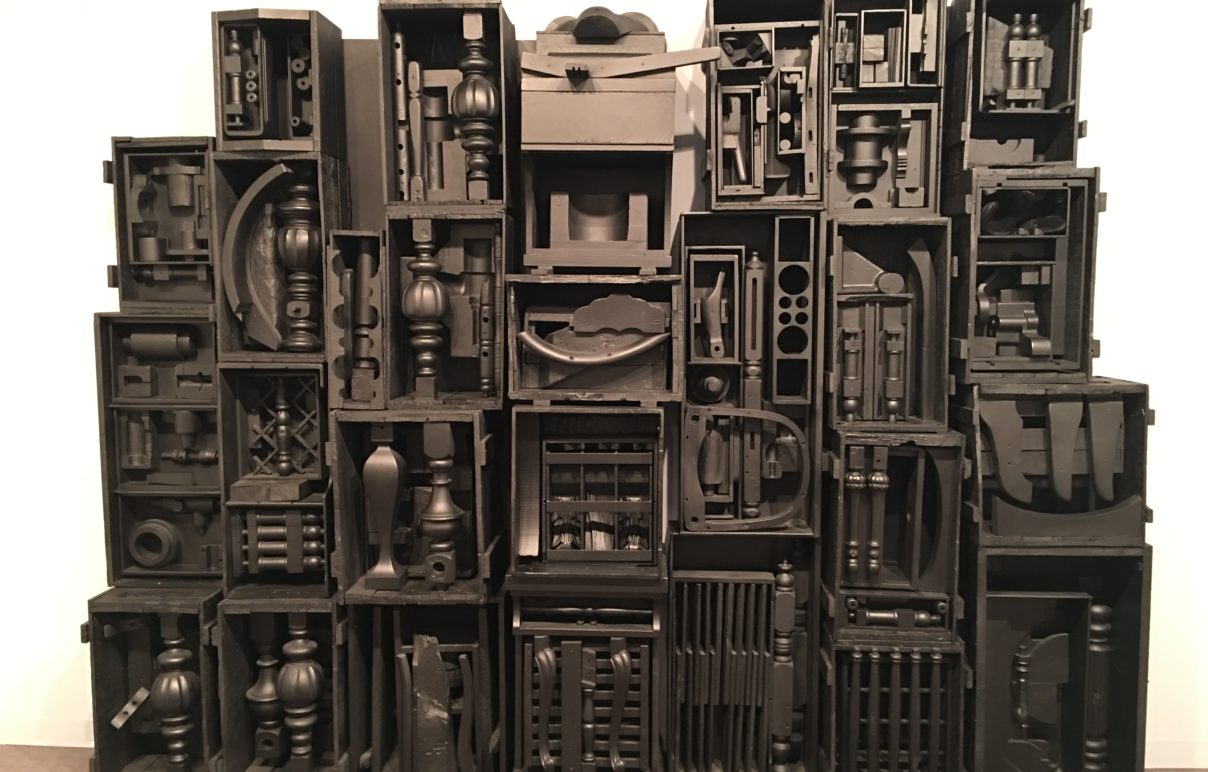
Louise Nevelson, Untitled, 1964. Wood painted black. 8’ 4” x 10’ 11 1/2″ x 1’ 6 3/4″. 16 elements, plus two-part base, 18 parts total. Image our own, details courtesy of Pace Gallery.
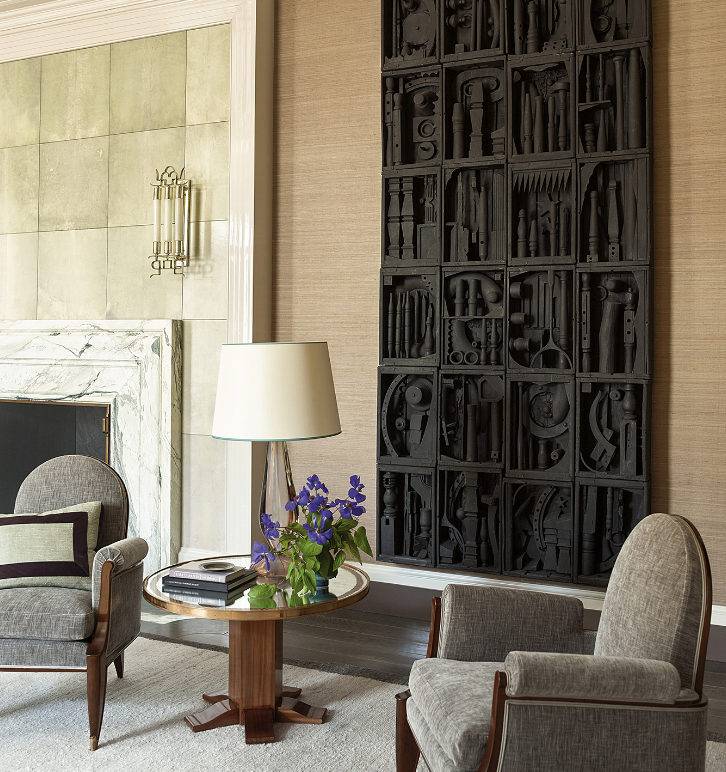
Shown in Galerie Magazine, designer Steven Gambrel recently designed an art collector’s Park Avenue apartment containing a matte black wall sculpture by Louise Nevelson.
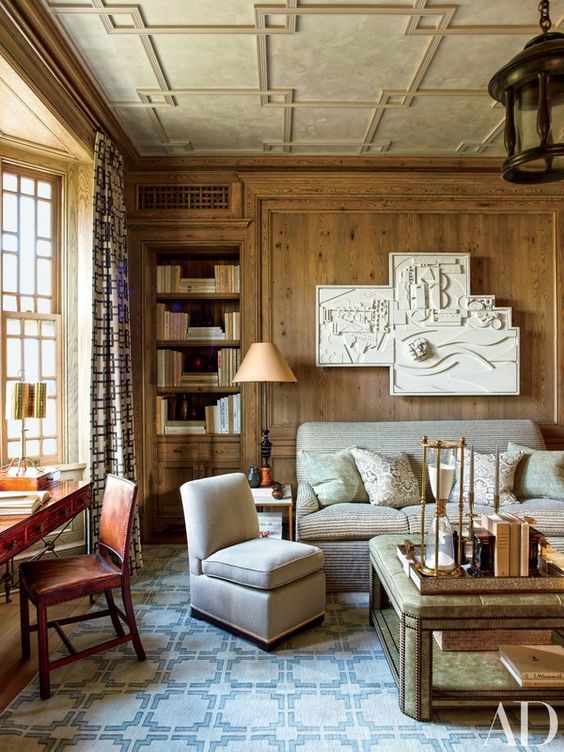
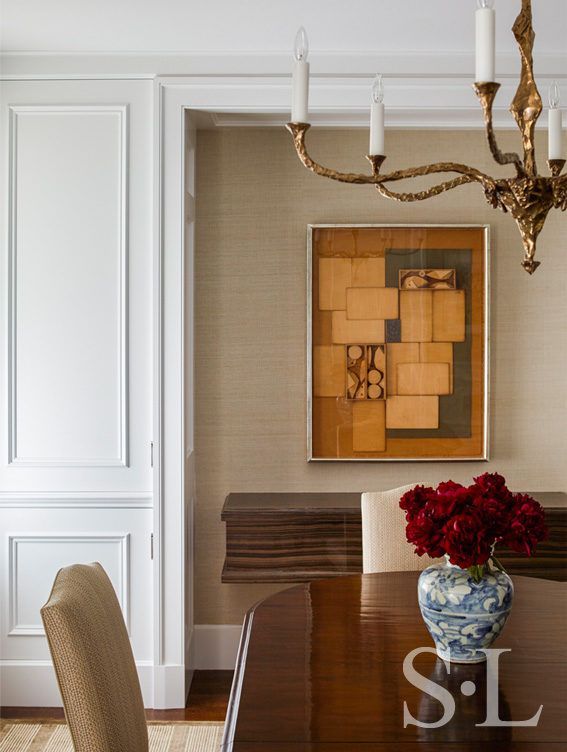
Louise Nevelson, Wood Paper Stone Collage, 1979. 42” x 32 1/8”. Another work by Nevelson embodies contained elegance in the dining room above a console table in our client’s Gold Coast Penthouse.
Today a foundation exists to preserve her legacy and educate the public and celebrate the life and work of Louise Nevelson.
